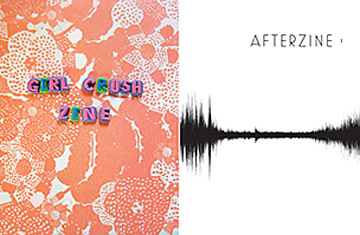
Girl Crush Zine and Afterzine
(2 of 2)
Purists may have additional definitions. "I value the zine's connection to anarchic-punk, DIY values," says Jenna Freedman, a self-professed "zine snob," who makes Lower East Side Librarian and curates Barnard's zine library. She prizes activism-oriented zines like Shotgun Seamstress, which explores the intersections of racial and sexual identity; or Functionally Ill, in which a woman identified only as Laura-Marie records, among other things, the voices she hears during bipolar disorder–associated mania. Though the new wave of zines is less esoteric, Freedman still sees something subversive in it. "This new phenomenon among mainstream journalists could certainly come out of that DIY sensibility," she says. "Maybe they're not doing their own binding, but they are saying 'I don't want an editor — I have something to say and I want it to go out unmediated.'"
The first zines appeared in the 1930s, when science fiction enthusiasts began to self-publish and trade their own volumes of fan fiction. These were called "fan magazines," shortened to fanzines. Fanzines found renewed popularity in the '70s and '80s in the underground punk scene, where followers of various bands would sell their homemade 'tribute' publications — usually black-and-white photocopies stapled together — at shows. In the '90s, feminism and punk converged in some counter-culture communities, creating a third-wave feminism movement named for the first zine to identify it: Riot Grrrl, associated with bands such as Bratmobile, Sleater-Kinney and Bikini Kill. The zines of that era used the machismo and swagger of hardcore to spotlight feminine steeliness in the face of misogyny.
"There was a sense of putting out unpolished writing that was thrilling," says Johanna Fateman, who first made a riot grrrl zine called Snarla with her best friend from high school, the filmmaker and writer Miranda July, while living in Portland, Ore. in 1991. (After Fateman gave a copy of Snarla to Bikini Kill frontwoman Kathleen Hanna after a show, the two became friends and later founded the band Le Tigre). "There were no rules: we went freely between prose and poetry and collage. There were no censors."
That freedom often fostered a confessional, stream-of-consciousness style that now looks like a forerunner of personal blogging. A crucial difference is that a post on the Internet can go viral, quickly leaving the relative safety of a dedicated readership for the digital echo chamber. But to criticize a zine, you have to take the time to write the creator a letter — and you have to have found the zine in the first place. Attendees at the Girl Crush party, who paid $10 for the zine, were of a type; the party was advertised on the contributors' blogs and via Facebook, and the people who attended already knew what a Girl Crush was. Many of them were writers themselves and understood the importance of having a place to try something new. In "Say Anything," Jenna Wortham chronicles her former infatuations and, in a few swift paragraphs, reveals nothing less than how she became herself, taking us from ages 9 to 23. In "Five Recipes for Your Girl Crush," Nozlee Samadzadeh describes her crush on novelist Emma Straub through the brunch she cooked in Straub's honor. Amanda Fortini's ode to Janet Malcolm reveals the excruciating awkwardness of meeting someone with whom you already have a relationship — but only through her work.
Not all of the essays in Girl Crush are as successful, but even the lesser contributions offer a privileged glimpse — not often seen in more mainstream publications — of thoughts as they are actually developed: not just the whittled, well-presented thesis, but the entire messy thing. Recalling what she loved about making the influential zine Chickfactor, music journalist Gail O'Hara describes how different it was from her day job at Spin: "The words were in context. It wasn't, 'Here's my story of what happened when I went to interview Guided By Voices.' It was, 'This is what they actually said. Here's the whole conversation.'"
